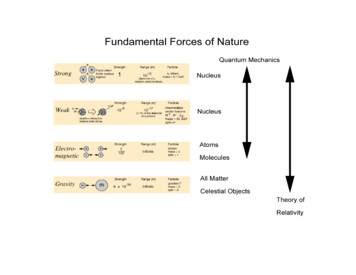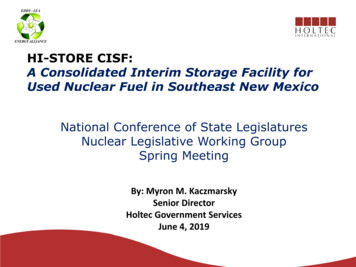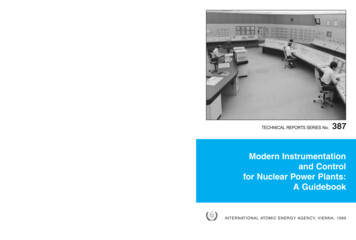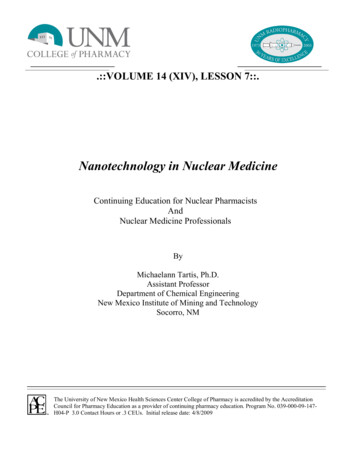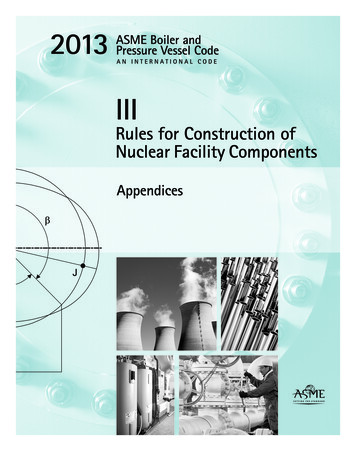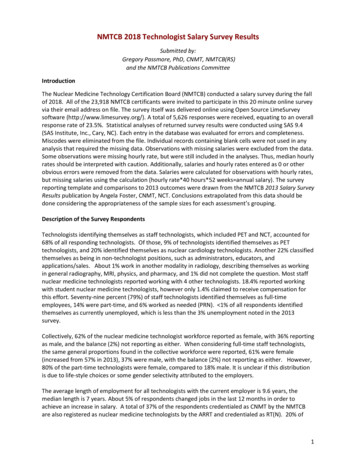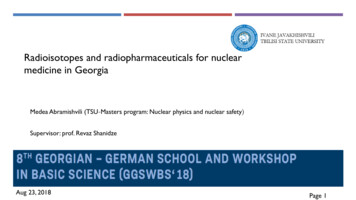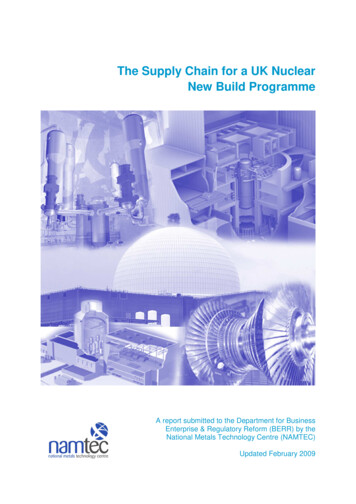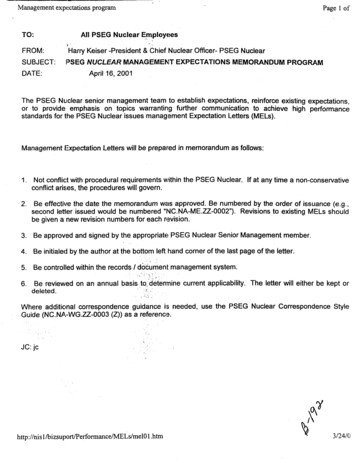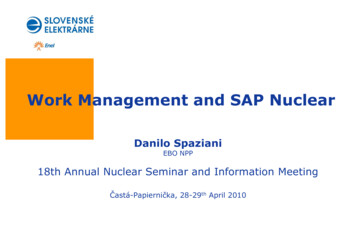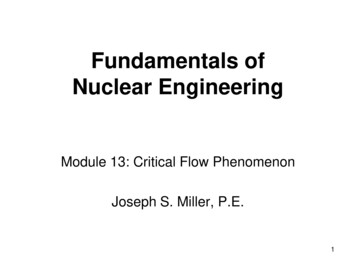
Transcription
Fundamentals ofNuclear EngineeringModule 13: Critical Flow PhenomenonJoseph S. Miller, P.E.1
2
Objectives:Previous Lectures described single and two-phase fluidflow in various systems. This lecture:1. Describe Critical Flow – What is it2. Describe Single Phase Critical Flow3. Describe Two-Phase Critical Flow4. Describe Situations Where Critical Flow isImportant5. Describe origins and use of Some Critical FlowCorrelations6. Describe Some Testing that has been Performedfor break flow and system performance3
Critical Flow Phenomenon4
1. What is Critical Flow? Envision 2 volumes at different pressures suddenly connected Critical flow (“choked flow”) involves situation where fluidmoves from higher pressure volume at speed limited only byspeed of sound for fluid – such as LOCA Various models exist to describe this limiting flow rate: One-phase vapor, one phase liquid, subcooled flashing liquid,saturated flashing liquid, and two-phase conditions5
2. Critical Single Phase FlowThree Examples will be given1.Steam Flow2.Ideal Gas3.Incompressible Liquid6
Critical Single Phase Flow - Steam In single phase flow: sonic velocity a and critical mass floware directly related:2(,)gvPTa2 c dv( P, T ) dP Sgc222Gcrit a ρ ( P, T ) dv( P, T ) dP S Derivative term is total derivative of specific volumeevaluated at constant entropy Tabulated values of critical steam flow can be found insteam tables7
Example Critical Steam Flow Calculation Assume 2 in2 steam reliefvalve opens at 1000 psi What is steam massdischarge rate? Assume saturated systemwith Tsat 544.61 F f 50.3 Wcrit f P A (50.3lb-m/hr)(1000 psi)(2 in2) 100,600 lb-m/hr 27.94 lb-m/sec.8
Mass flow rate of a gas at chokedconditions for Ideal GasAll gases flow from upstream higher stagnation pressure sources todownstream lower pressure sources. There are several situations in whichchoked flow occurs, such as: change of cross section (as in a convergentdivergent nozzle or flow through an orifice plate.When the gas velocity is choked, the equation for the mass flow rate in SI metric units is:m or for an ideal gasm where:m mass flow rate, kg/sC discharge coefficient, dimensionless (usually about 0.72)A discharge hole cross-sectional area, m²k cp/cv of the gascp specific heat of the gas at constant pressurecv specific heat of the gas at constant volumeρ real gas density at P and T, kg/m³P absolute upstream stagnation pressure, PaM the gas molecular mass, kg/kmole (also known as the molecular weight)R Universal gas law constant 8314.5 (N·m) / (kmole·K)T absolute gas temperature, KZ the gas compressibility factor at P and T, dimensionless9
Critical Single Phase Flow – IncompressibleLiquid (Lahey and Moody, Ref. 1)Where throat pressure, pr, is equal to the downstream receiver pressure, pR,and Gl, is the so-called Bernoulli mass flux.10
Critical Single Phase Flow – IdealGas(Lahey and Moody, Ref. 1) (cont)11
Ideal Gas Flow Rate12
3. Two-phase Critical Flow Using MoodyEquilibrium Flow Model (Refs. 1 & 2)13
Two-phase Critical Flow Using MoodyEquilibrium Flow Model (Refs. 1 & 2)14
Two-phase Critical Flow Using MoodyEquilibrium Flow Model (Refs. 1 & 2) (cont)That is, for a known stagnation state, local static pressure, p, and slip ratio, S, the flow rate unitarea is uniquely determined. From numerous experimental and theoretical studies, the slipratio, S, has been determined to range from S 1.0 (homogeneous) to S (ρf / ρg)1/2 .For condition imposed by Moody, the slip ratio is evaluated asS S(p) (ρf / ρg)1/3 .(9.53)Equation (9.53) shows that at a maximum G, the slip ration is a function of pressure only.Employing Eq. (9.53) in Eq. (9.52) and using saturated steam-water properties, Fig. 9-10a canbe obtained, which gives Gc in terms of p0 and h0 .15
Two-phase Critical Flow Using MoodyEquilibrium Flow Model (Refs. 1 & 2) (cont)16
Example CalculationFrom page 8 for sat steam at 1000 psia:Wcrit f P A (50.3lb-m/hr)(1000 psi)(2 in2) 100,600 lb-m/hr 27.94 lb-m/sec.What is this value when using Moody table onpage 16?Gc(P 1000, h 1193) 2000 lbm/sec-ft2Wcrit/A (27.94 lbm/sec)/ (2 in2 / 144 in2/ft2 )Wcrit/A 2012 lbm/sec-ft2Checks17
Two-phase Critical Flow Using MoodyHomogeneous Equilibrium Model (Ref. 1 & 2) (cont)18
Two-phase Critical Flow Comparing Moody,HEM and Bernoulli (Refs. 1 & 2) (cont)19
Henry-Fauske/ Homogeneous EquilibriumCritical Flow Transition Model20
Brunell Critical Flow for Flashing Water As with anything dealing withtwo phase flow: Assumed Slip Ratio affectstwo-phase critical flowcorrelations. For example: Burnelldeveloped critical flowcorrelation for flow of flashingwater in short pipes andorificesGcrit (2gcρl(P – (1-C)Psat))1/2 Other critical flowcorrelations exist for differentassumed regimes21
4. Where is Critical Flow Important Used in LOCA break flow calculationsMain Steam Line BreaksMaximum flow in a orificeSafety Valve Opening
LOCA break flow calculations Small BreaksLarge BreaksIntermediate BreaksInclude Break side and discharge side,especially to determine flow into acontainment or sub compartment
Break Flow from Discharge Pipefor double-ended RuptureReference: NEDO 24548ASSUMPTIONS: The initial Velocity of the fluid in the pipe is zero. When considering bothsides of the break, the effects of initial velocities would tend to cancel out. Constant reservoir pressure at 1000 psia at saturated liquid conditions. Initially fluid conditions inside the pipe on both sides of the break are similar. Wall thickness of the pipe is small compared to the diameter. Subcompartment pressure 0 psig. Quasi-steady mass flux is calculated using the Moody steady slip flow modelwith subcooling.
Nomenclature and DefinitionsABR - Break Area, ftAL - Minimum cross-sectional area between the vessel and the break. Thisis the sum of the area of parallel flow paths.c1 - Sonic speed in the fluidD - Pipe inside diameter at the break location, ftFI - Inventory flow multiplierFI 0.75 for saturated steamFI 0.50 for liquidgc - Proportionality constant ( 32.17 lbm-ft/lbf-sec2)G1 - Mass Flux, lbm/ft2 -secGc - Maximum mass flux, lbm/ft2 -secho - Reservoir or vessel enthalpy, BTU/lbmhp - Initial enthalpy of the fluid in the pipe, BTU/lbmLI - Inventory length. The distance between the break and the nearestarea decrease of AL .- Mass Flowrate, lbm/sec- Mass flowrate during the inventory period, lbm/secPo - Reservoir or vessel pressure, 1000 psiaPsat - Saturation pressure for liquid with an enthalpy of hpt- Time, sec- Length of the inventory period, sectIv- specific volume of the fluid initially in the pipe, ft 3/ lbmVI - Volume of the pipe between the break and AL , ft 3X- Separation distance of the break, ft
Sonic Speed in Water versusWater Pressure
Moody Equilibrium Critical Flow withSlip Extended into Subcooled Region
Short Term Release Rate CalculationsShort Term Release Rate CalculationsBtuhf : 542.6lbmFrom ASME Steam Tablesho : hfFI : 0.50 for liquid from NEDO-24548 pg.11D : 2.5DL : 0.5LI : 26Inside diameter of pipe at break down locationftDiameter of restrictionft( Assumed)The distance between break and nearest restrictionftPo : 1000( Assumed)psiInitial pressure
Short Term Release Rate Calculations (cont)lbmGc : 7500ft2G1 : Gcmass flux from Moody Plotsft2c 1 : 1.6 10v : 0.02159ABR : Maximum mass flux from Moody Plots1sftsonic speed in the fluid (from Sonic Speed in Water vs. Water Pressure Figure3.lbmspecific volume of fluid initially in the pipe from ASME Steam Tables2π DABR 4.909 ft22AL 0.196ft2Mimimum cross sectional area between vessel and breakVI : ABR LIVI 127.627ft3Volume of the pipe between the break and ALAL : 144π DLBreak Area
Short Term Release Rate Calculations (cont)ALA BRIf 0.04ALA BRt I : IfALA BRFI 0.5 FI(2 LI)t I 0.325c1sec FIt I. : VIA BR G1 FI vt I. 0.321sec
Short Term Release Rate Calculations (cont)lb4MI : G1 ABR FIMI 1.841 10Mss : AL G1Mss 1.473 103Flowduring tIseclbSteady state flow throughrestriction after tIsec2 .10Flow In Discharge Pipe (lb/sec)41.5 .104M1 .1045000000.20.40.60.8tITime after Break (sec)31
5. Describe Origins and Use of Critical FlowCorrelations32
5. Describe Origins and Use of Critical FlowCorrelations (cont.)33
5. Describe Origins and Use ofCritical Flow Correlations (cont.)
5. Describe Origins and Use of Critical FlowCorrelations (cont.)35
5. Describe Origins and Use ofCritical Flow Correlations (cont.)
Use of Critical Flow Correlationsin Nuclear Applications Most common use of HEM, Moody, andHenry Fauske Used in LOCA break flow calculations Main Steam Line Breaks Maximum flow in a orifice Safety Valve Opening
Use of Critical Flow Correlationsin Nuclear Applications (cont.)10CFR50 Appendix K--ECCS Evaluation ModelsI. Required and Acceptable Features of the Evaluation ModelsC. Blowdown Phenomenab. Discharge Model. For all times after the discharging fluid has beencalculated to be two-phase in composition, the discharge rate shall becalculated by use of the Moody model (F.J. Moody, "Maximum Flow Rate ofa Single Component, Two-Phase Mixture," Journal of Heat Transfer, TransAmerican Society of Mechanical Engineers, 87, No. 1, February, 1965). Thecalculation shall be conducted with at least three values of a dischargecoefficient applied to the postulated break area, these values spanning therange from 0.6 to 1.0. If the results indicate that the maximum cladtemperature for the hypothetical accident is to be found at an even lowervalue of the discharge coefficient, the range of discharge coefficients shallbe extended until the maximum clad temperatures calculated by thisvariation has been achieved.
Henry/Fauske Critical Flow39
Moody Critical Flow40
HEM Critical Flow41
H/F versus Moody Extended Subcooled42
6. Describe Some Testing That has BeenPerformed CSNI Code Validation lINTEGRAL TEST DATACode Validation Matrix of Thermo-Hydraulic Codes for LWR LOCA andTransientsGENERALCSNI Integral Test Facility Validation Matrix for the Assessment of Thermal-Hydraulic Codes for LWR LOCA and TransientsPrepared by a Writing Group Committee of the PWG 2 "Task Group on Thermal-Hydraulic System Behaviour"OCDE/GD(97)12, NEA/CSNI/R(96)17 (July 1996)BETHSYThe BETHSY integral test facility located in the Nuclear Research Center in Grenoble (France) is a scaled downmodel of a 3 loop 900 eMW FRAMATOME PWR; the overall scaling factor applied to every volume, mass flowrateand power level is close to 1/100, while elevations are 1/1 in order to preserve the gravitational heads.DOEL2DOEL 2 is a Westinghouse, 2 loop pressurized water reactor (PWR) rated at 392 Mwe (NET) and commissioned in 1975,for which TRACTEBEL was the architect/engineer. This plant located in Belgium in part of the twin concept with DOEL 1, asthey share some common engineered safety systems such as the high pressure safety injection system (HPSI). Datameasured during the Steam Generator Tube Rupture (SGTR) incident on full scale facility are available.43
Describe Some Testing That has BeenPerformed (cont)FISTBWR/6-218 standard plant. A full size bundle with electrically heated rods is used to simulate the reactor core. A scalingratio of 1/624 is applied in the design of the system components. Key features of the FIST facility include: (1) Full height testvessel and internals; (2) correctly scaled fluid volume distribution; (3) simulation of ECCS, S/RV, and ADS; (4) level tripcapability; (5) heated feedwater supply system, which provides the capability for steady state operation.FIX-IIMay 31,1988 report: FIX-II/2032, BWR Pump Trip Experiment 2032, Simulation Mass Flow and Power Transients. In theFIX-II pump trip experiments, mass flow and power transients were simulated subsequent to a total loss of power to therecirculation pumps in an internal pump boiling water reactor. The aim was to determine the initial power limit to give dryoutin the fuel bundle for the specified transient. In addition, the peak cladding temperature was measured and the rewettingwas studied.LEIBSTADTAugust 17, 1989 report: LEIBSTADT/STP-2001, BWR/6, Reactor Core Isolation Cooling System Test. The LeibstadtNuclear Power Station is equipped with a direct cycle boiling water reactor belonging to the General Electric BWR productline BWR/6. The MARK III containment system encloses the nuclear island. The nuclear system is provided with a 238-inchinternal diameter vessel and the core is built up of 648 fuel elements and 84 control rods. Each fuel bundle consists of 62fuel rods and 2 water rods in an 8 x 8 array. The rated power of the Leibstadt BWR is 3012 MWt and it is designed for a netpower of 942 MWe.44
Describe Some Testing That has BeenPerformed (cont)LOBIMay 22,1992 report: LOBI/A1-04R, Loop for Blowdown Investigation, PWR Double-Ended Cold-Leg Break Test TEST.The LOBI facility is a 1/700 scale model of a four loop PWR and has two primary loops, the intact loop representing threeloops and the broken loop representing one loop of a four-loop PWR. The reactor pressure vessel model contains anelectrically heated rod-bundle with 64 rods and a heated length of 3.9 m. The nominal heating power is 5.3 MW. Thedowncomer is of annular shape. An upper head simulator is connected to the vessel. Each of the two primary loops containsa pump and a steam generator. The different mass flows in the loops are established by the pump speeds, since the twopumps are identical. Heat is removed from the steam generators by a secondary system. ECC water can be supplied fromtwo accumulators, one for each loop. Cold or hot leg as well as combined injection can be simulated.The LOBI test facility is the only high pressure integral test facility within the European Communities (1982), built andoperated in the Joint Research Centre, Ispra, ITALY. In the LOBI experiments the thermal-hydraulic behavior of the facilityduring a transient, caused by a simulated loss of coolant accident (LOCA), is investigated to provide an experimental basisfor analytical model development and code verification.LOFTMay 26,1992 report: The LOFT Integral Test Facility is a scale model of a LPWR. The intent of the facility is to model thenuclear, thermal-hydraulic phenomena which would take place in a LPWR during a LOCA. The general philosophy in scalingcoolant volumes and flow areas in LOFT was to use the ratio of the LOFT core [50 MW(t)] to a typical LPWR core [3000MW(t)]. For some components, this factor is not applied; however, it is used as extensively as practical. In general,components used in LOFT are similar in design to those of a LPWR. Because of scaling and component design, the LOFTLOCA is expected to closely model a LPWR LOCA.45
Describe Some Testing That has BeenPerformed (cont)OTISMay 22,1992 report: OTIS is a 1:1686 volume-scaled single loop (one hot log and one cold leg) facility with criticalelevations preserved. The single once-through steam generator contains 19 tubes prototypical of a B&W PWR plant. Theelectrically heated core has a power capability of 180 KW which is representative of 10 per cent scaled power based on a2584 MWth plant. It contains no primary pump but all other active components are simulated and it operates at full PWRsystem pressure. The facility tests natural circulation in 1-phase flow; boiler condenser mode; leak flow; heat transfer incovered core; non- condensable gas effects; intermittent two-phase natural circulation; natural circulation in core, vent valve,downcomer; superheating in secondary side.PACTELNov 26,1998 report: The main goal was to study natural circulation in a VVER plant including several single- and two-phasenatural circulation modes. The heat generated in the core is transported by the coolant to the steam generators. The steamgenerator secondary side conditions were held constant, eliminating disturbances caused by the secondary pressurevariation. The primary coolant mass was reduced stepwise in the liquid form, and the amount of the drained water was givenas a boundary condition. The draining period is very short compared to the stabilizing period, therefore the different naturalcirculation mechanisms are clearly identified. It was expected that the characteristics of natural circulation at constantpressure is mostly dependent on the primary coolant inventory and the core power level. During the whole experiment thesteam generator level control was maintained. The secondary pressure was controlled by a PI controller.PIPERApr 13,1989 report: The PIPER-ONE facility simulates a General Electric BWR-6 plant. It is characterized by volume andheight scaling ratios of 1/2200 and 1/1, respectively. The available core rod electrical power (20% of the nominal value) issufficient to simulate the nuclear heat decay. No circulation loops are included in the facility, considering their lowimportance in a small break LOCA and the willingness to achieve the maximum simplicity of the loop operation.46
Describe Some Testing That has BeenPerformed (cont)PKLApr 01,1981 report: PKL-facility simulates the essential primary system components of a typical West German 1300 PWRwith regard to their thermohydraulic behaviour. The facility essentially consists of the pressure vessel with the heatedbundle, the downcomer simulator, the primary loops with the components steam generator and pump simulator, the injectiondevices, the break geometry simulator, as well as the separators connected thereto, and the test containment to maintain aback-pressure at the location of break which is expected to be typical for emergency conditions. The number of heater rodsand the cross-sections of the testing plant are on a reduced scale 1:134 in comparison with a typical German PWR. Theelevations and locations are essentially full scale. Pressure vessel: The space between the pressure vessel and the innercore casing is sealed from the core region and the upper and lower plenum and connected with the upper plenum only by apressure equalization line. The rod bundle surrounded by the inner core casing consists of 340 rods, 337 of which areindirect electrically heated. The test bundle cross-section as well as a heater element with the measuring elevations, theoriginal-KWU-spacers and the axial power profile (7 power steps) are described.ROSA-IIIJune 29,1992 report: This is one of the small break LOCA/ECC test series to study the response of a BWR with ECCinjection. Run 912 is a 5% split break test at the recirculation pump inlet. The test is initiated with the steam dome pressureat 7.30 MPa, the lower plenum subcooling at 10.8 K, a core inlet flow rate of 16.4 kg/s, and a core heat generation rate of3.9 MW. The core is quenched after ECCS actuation and at a maximum fuel cladding temperature of 839 K.ROSA-IVJune 29,1992 report: ROSA-IV is a large scale test facility (LSTF) for integral simulation of thermal-hydraulic response of apressurized water reactor during a small break loss-of-coolant accident or an operational transient. The facility has electriccore heating. The overall scaling factor is 1/48. The hot and cold legs were sized to conserve the volume scaling. The fourprimary loops of the reference PWR are represented by two equal-volume loops.47
Describe Some Testing That has BeenPerformed (cont)SEMISCALEMay 1,1987 report: The Semiscale Mod-3B system is scaled to a reference four-loop PWR. The scaling criterion is aModified volume scaling based on the ratio of Semiscale power to the thermal power of the reference plant (Trojan). ThisScaling produces a scale factor of 1/1705.5. The system consists of a pressure vessel with an electrically-heated, 25-rodPWR core simulator and internals, an external pipe downcomer, and two primary coolant loops. Each loop has an activetube and shell steam generator. The intact loop is scaled to represent three of the four primary loops in a PWR, while thebroken loop represents the fourth. Even though S-PL-3 does not incorporate a break, this loop is referred to as the "brokenloop". In order to correctly scale the facility and preserve important phenomena, component elevations, dynamic pressureheads, and liquid distributions are maintained as close to the reference PWR values as possible.SPESApr 1,2003 report: The SPES (Simulatore PWR per Esperienze di Sicurezza) integral test facility is a three loop scaleddown model of PWR (Westinghouse 3122 type, 3 loops, 2775 MWth core power) designed for thermal-hydraulic safetyresearch program. SPES test program provides experimental data for the development and assessment of system codesused in PWR safety analysis. SPES is an experimental facility which allows a true simulation of a PWR system as close aspossible to the characteristic of the Westinghouse 312 type. The test plant reproduces the primary loops, the most importantcomponents and the power channel of the simulated reactor according to significant scaling criteria. The SPES experimentalfacility, having a 1:427 power-scaling ratio includes a full-length-scale electrical heated power channel and three completeprimary loops.TBLApr 21,1989 report: Two Bundle Loop facility. Volume scaling ratio 1:328. Height ratio 1:1. The facilities include thefollowing to simulate a BWR system: pressure vessel, main steam system, feedwater, recirculation, ECCS, ADS, break line,utility system, power supply and instrumentation system. The pressure vessel has two heated simulated fuel assemblies.48
Describe Some Testing That has BeenPerformed (cont)TLTAMay 22,1992 report: The Two-Loop-Test-Apparatus (TLTA) is a 1:624 volume scaled BWR/6 simulator. It was thepredecessor of the better-scaled FIST facility. The facility is capable of full BWR system pressure and has a simulated corewith a full size 8 x 8, full power single bundle of indirect electrically heated rods. All major BWR systems are simulatedincluding lower plenum, guide tube, core region (bundle and bypass), upper plenum, steam separator, steam dome, annulardowncomer, recirculation loops and ECC injection systems. The fundamental scaling consideration was to achieve real-timeresponse. A number of the scaling compromises present in TLTA were corrected in the FIST configuration. Thesecompromises include a number of regional volumes and component elevations.MARVIKENDec 1979 report: Marviken Full Scale Critical Flow Tests. The major components of the facility are:The pressure vessel with a net volume 425 m3, a maximum design pressure 5.75 MPa and a maximum designtemperature 545 K.- The discharge pipe attached to the pressure vessel bottom. The discharge pipe consists of a ball valve and pipespools which house the instrumentation upstream of the test nozzle.- The test nozzles and rupture disc assemblies. A set of test nozzles of specified lengths and diameters (tubularsection lengths from 0.166 to 1.809 m and tubular section diameters from 0.2 to 0.509 m) were used to which therupture disc assemblies were attached.- The containment and exhaust pipes, consisting of the drywell, the wetwell, fuel element transport hall, the groundlevel exhaust pipe, and the upper exhaust pipe.49
Example of Test Reports:Semiscale TestingSummary Report Semiscale Mod-2A Heat Loss Characterization TestSeries (EGG-SEMI-5448)SEMI R1.pdf Semiscale Mod-1 Program and System Description for theBlowdown Heat Transfer Tests (ANCR-1230)SEMI R2.pdf An Evaluation of Piping Heat Transfer Piping Flow Regimes,and Steam Generator Heat Transfer for the Semiscale Mod-1 IsothermalTests (ANCR-1229)SEMI R3.pdf RELAP5 Standard Model Description for the Semiscale Mod2A System (EGG-SEMI-5692)SEMI R4.pdf Steady State Control Model for the Standard RELAP5Semiscale Mod-2A System Model (RE-A-82-023)SEMI R5.pdf Summary of the Semiscale Program (1965-1986)(NUREG/CR-4945-EGG-2509)SEMI R6.pdf Semiscale Loss-of-Power Test Results 11th Water ReactorSafety Research Information Meeting, October 24-28, 1983 (ECC-M22283 Preprint)SEMI R7.pdf Semiscale Program Description (TREE-NUREG-1210)50
Summary Critical Flow is used often in determining maximum flowthrough breaks and safety valves. HEM, Burnell, Bernoulli, Henry-Fauske and Moody aresignificant critical flow correlations used in the nuclearpower industry. Many tests have been conducted to validate the criticalflows that are used for safety analysis of nuclear powerplants.51
Selected References1. R.T. Lahey, Jr. And F.J. Moody, 1977. The ThermalHydraulics of a Boiling Water Nuclear Reactor, ANS ,LaGrange Park, Ill.2. Moody, F.J., Maximum Flow Rate of a SingleComponent, Two-Phase Mixture, ASME Paper 64-HT35 (1964).3. Moody, F.J., Maximum Flow Rate of a SingleComponent, Two-Phase Mixture, J. Heat Transfer,Trans ASME, Ser. C, 87, 134 (1965).4. B. Chexal, et al. 1991. The Chexal–Lellouche voidfraction correlation for generalized application, EPRINSAC-139.52
Selected References (Cont)5. R.E. Henry, H.F. Fauske, The two-phase critical flow ofone component mixtures in nozzles, orifices and shortpipes, ASME J. Heat Transfer 93 (1971).6. F. D’Auria and P. Vigi, Two-Phase Flow Models – Atechnical Addendum to the CSNI State of the Art Reporton Critical Flow Modeling, CSNI Report No. 49, NuclearEnergy Agency, Comitato Nazionale Per L’EnergiaNucleare, Rome, (May 1980)7. F.R. Zaloudek, The Critical Flow of Hot Water ThroughShort Tubes, HW-77594, General Electric, HartfordAtomic Products Operation, Richland, Washington,(May 1, 1963).53
Selected References (Cont)8. G.S. Lellouche, B.A. Zolotar, Mechanistic model forpredicting two-phase void fraction for water in verticaltubes, channels and rod bundles, EPRI NP 2246-SR(1982).9. F.J. Moody, Maximum two-phase vessel blowdown frompipes, ASME J. Heat Transfer (1966).10. F.J. Moody, A pressure pulse model for two-phasecritical flow and sonic velocity, J. Heat Transfer, (August1969).11. Wallis, G.B., One Dimensional Two-Phase Flow. McGraw Hill, New York. (1969)54
55
56
57
58
specific volume of fluid initially in the pipe from ASME Steam Tables ABR 1 4 πD 2: ABR 4.909 ft 2 Break Area AL 1 4 πDL 2: AL 0.196 ft 2 Mimimum cross sectional area between vessel and break VI: ABR LI VI 127.627 ft 3 Volume of the pipe between the
